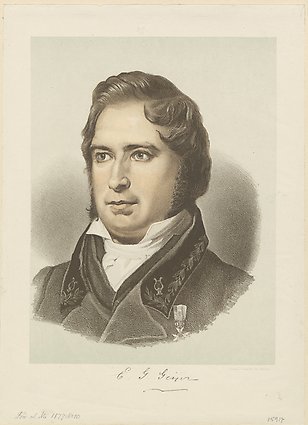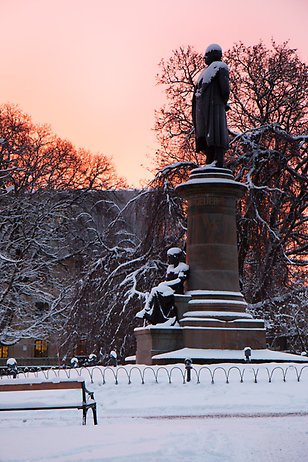Erik Gustaf Geijer

Erik Gustaf Geijer was born the son of a mill owner in Ransäter in Värmland in 1783. He started his studies at Uppsala University in 1799 and received a Master’s degree in 1806.
At the age of 20, he published his first written work, “In Honourable Memory of Sten Sture the Elder”, which won him the Swedish Academy’s Grand Prize.
In 1817, Geijer became professor of history and he held this chair until his retirement as professor emeritus in 1846. On four occasions he served as the University’s Vice-Chancellor. In those days the Vice-Chancellor was elected to serve for six months at a time.
Geijer was primarily a historian. He was, according to Uppsala’s Karl-Gustaf Hildebrand, “one of the few Swedish historians who viewed history in general as problematic” and he stressed “the importance of a history that encompasses all social classes”. This is why he has remained strikingly modern.
However, he did not just live in the past; he took an active part in contemporary political debate, including at national level. From his original conservative outlook, he shifted in 1838 to a liberal view of society. This step, which was called “Geijer’s apostasy”, appalled many of his old friends. He defended his new ideology in the periodical Litteraturbladet, which he founded. It was this liberalism which led to his strong opposition to the slavery in the Swedish colony of Saint-Barthélemy. In his book Den blå boken (“The Blue Book”, 1837) he called for the abolition of slavery and in 1840–1841 he submitted motions to the Swedish parliament on the issue.
He was popular with Uppsala students, but this did not prevent him from coming into conflict with them on one occasion when he was forced to take unpopular decisions on orders from the king. This was during the years of growing Scandinavianism in the 1840s.
Regarding Geijer as a poet, some of his poetry can be said to be outdated. But some of his shorter lyrics are among the true gems of Swedish lyric poetry, such as “I know a greeting more dear than you, world, can offer” and “Thought, whose strife only night can see”. He was also an important composer – he has been called “the poet musician”.
According to much-quoted lines from one of his poems, though born among the blue hills of Värmland he was later “obliged to live by the River Fyris” in Uppsala. The apparent regret is really an expression of Geijer’s feeling for nature, since he actually enjoyed living in Uppsala. Nonetheless, when he became a professor emeritus he moved to Stockholm in order to have easier access to the archives there. He died in the capital in the spring of 1847, but his remains were brought to Uppsala and interred in the Old Churchyard.
Anyone walking from Uppsala city centre to the University Main Building cannot help but see him, Erik Gustaf Geijer, in the form of a statue standing in the middle of the University Park. The sculptor John Börjesson has portrayed Geijer as he looked when lecturing. Below him sits a woman playing music, called “Geijer’s Thoughts”. She was modelled on Geijer’s daughter Agnes. The statue was unveiled in 1880 in pouring rain.

The Geijer statue in University Park. Photo: David Naylor.
A literary historian once queried whether any single person ever had such an impact on a Swedish university as Geijer did in the 1820s and 1830s. The Geijer family continued to mean a great deal to the city and the University. The beautiful timbered house where the Geijers lived in 1837–1846, just next door to the University Library, is now a listed building and is known as Geijersgården.
